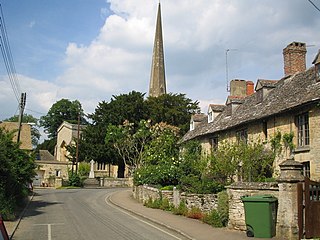
Kidlington is a suburb and civil parish in the Cherwell district of Oxfordshire, England. It is in-between the River Cherwell and Oxford Canal, 5 miles (8 km) north of Oxford and 8 miles (13 km) south-west of Bicester. It remains officially a village despite its size.
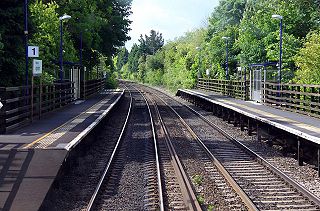
The Cherwell Valley line is the railway line between Didcot and Banbury via Oxford. It links the Great Western Main Line and the south to the Chiltern Main Line and the Midlands. The line follows the River Cherwell for much of its route between Banbury and Oxford.

Appleford railway station serves the village of Appleford-on-Thames in Oxfordshire, England, as well as nearby settlements such as Sutton Courtenay. It is on the Cherwell Valley Line between Didcot Parkway and Banbury, 55 miles 16 chains (88.8 km) measured from London Paddington. The station and all trains serving it are operated by Great Western Railway.

Pontrhythallt was a railway station in the village of Pont Rhythallt, Gwynedd, Wales. This station opened in 1869 and closed for regular passenger services in 1930, but trains continued to pass through until the last goods train of all on 3 September 1964, which delivered a panel of lap fencing.

Athy railway station serves the town of Athy in County Kildare, Ireland.

Shipton-on-Cherwell is a village on the River Cherwell about 2 miles (3 km) north of Kidlington in Oxfordshire, England. The village is part of the civil parish of Shipton-on-Cherwell and Thrupp.
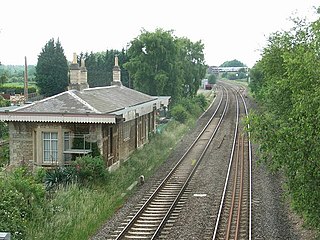
Aynho for Deddington railway station was a railway station serving the village of Aynho in Northamptonshire, England. It was on what is now known as the Cherwell Valley Line.
Wolvercot Platform was a halt on the Great Western Railway line between Oxford and Banbury. The line is now known as the Cherwell Valley Line or the "Oxford Canal Line".
Rollright Halt railway station served the village of Great Rollright in Oxfordshire, England.

Wainhill Crossing Halt was a halt on the Watlington and Princes Risborough Railway which the Great Western Railway opened in 1925 to serve the Oxfordshire hamlet of Wainhill. The opening of the halt was part of a GWR attempt to encourage more passengers on the line at a time when competition from bus services was drawing away patronage.

Blenheim & Woodstock was a railway station constructed in the neoclassical style which served the town of Woodstock and Blenheim Palace in the English county of Oxfordshire. The station, as well as the line, was constructed by the Duke of Marlborough and was privately run until 1897 when it became part of the Great Western Railway. The number of trains serving the station was cut in the late 1930s, and again in 1952 down to only six trains a day. The last train ran on 27 February 1954 adorned with a wreath.
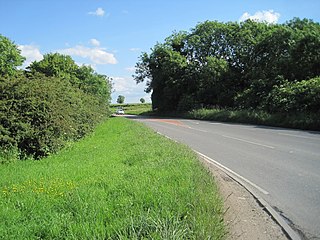
Shipton-on-Cherwell Halt was a railway halt constructed in 1929 by the Great Western Railway to serve the Oxfordshire village of Shipton-on-Cherwell as well as the adjacent Oxford and Shipton Cement Company limestone quarry and cement works.
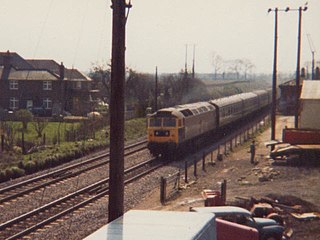
Kidlington railway station is a former railway station that opened in 1855 on the Oxford and Rugby Railway to serve the adjacent Oxfordshire village of Kidlington, and act as a railhead for the town of Woodstock, 2.5 miles (4.0 km) away. It became a junction station in 1890 upon the opening of the Blenheim and Woodstock Branch Line, and served the area for over 100 years before falling victim to the programme of closures initiated by the Beeching Report in 1964. Following many proposals for its reopening, a new station to serve Kidlington opened in October 2015 at Oxford Parkway on the Oxford to Bicester Line.

Little Stretton Halt was a minor railway station on the Welsh Marches Line between Craven Arms and Church Stretton in Shropshire, England.
Ullock railway station was built by the Whitehaven, Cleator and Egremont Railway. It served the village of Ullock, Cumbria, England.
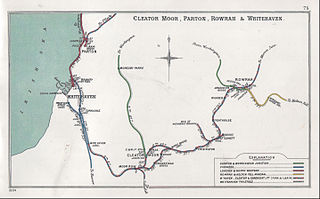
Winder railway station was built by the Whitehaven, Cleator and Egremont Railway. It served the village of Winder, Frizington, Cumbria, England.

Yeathouse railway station was a later addition to the Whitehaven, Cleator and Egremont Railway. It served the communities of Yeathouse and Eskett, near Frizington, Cumbria, England.

Frizington railway station was built by the Whitehaven, Cleator and Egremont Railway. It served the industrial Parkside area of Frizington, Cumbria, England.

Rosehill railway station was opened by the Cleator and Workington Junction Railway (C&WJR) on the company's Harrington Branch which connected with the Lowca Light Railway (LLR) at Rosehill to provide a through route from Lowca to Workington Central and beyond.
Allhallows Colliery railway station was in the former county of Cumberland, now Cumbria, England. It was a stop on the Bolton Loop of the Maryport and Carlisle Railway.












